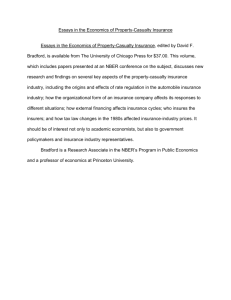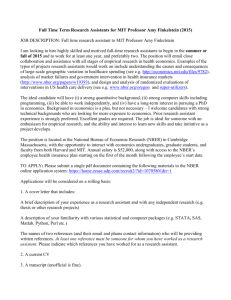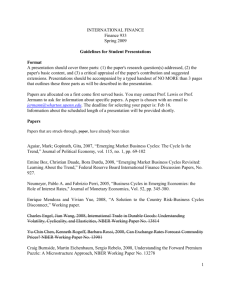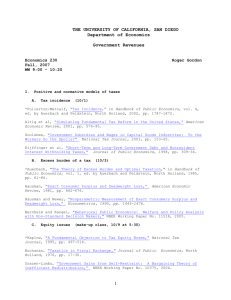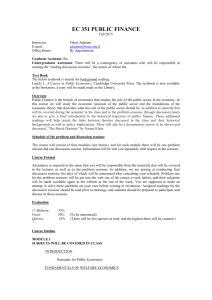- College of Business
advertisement
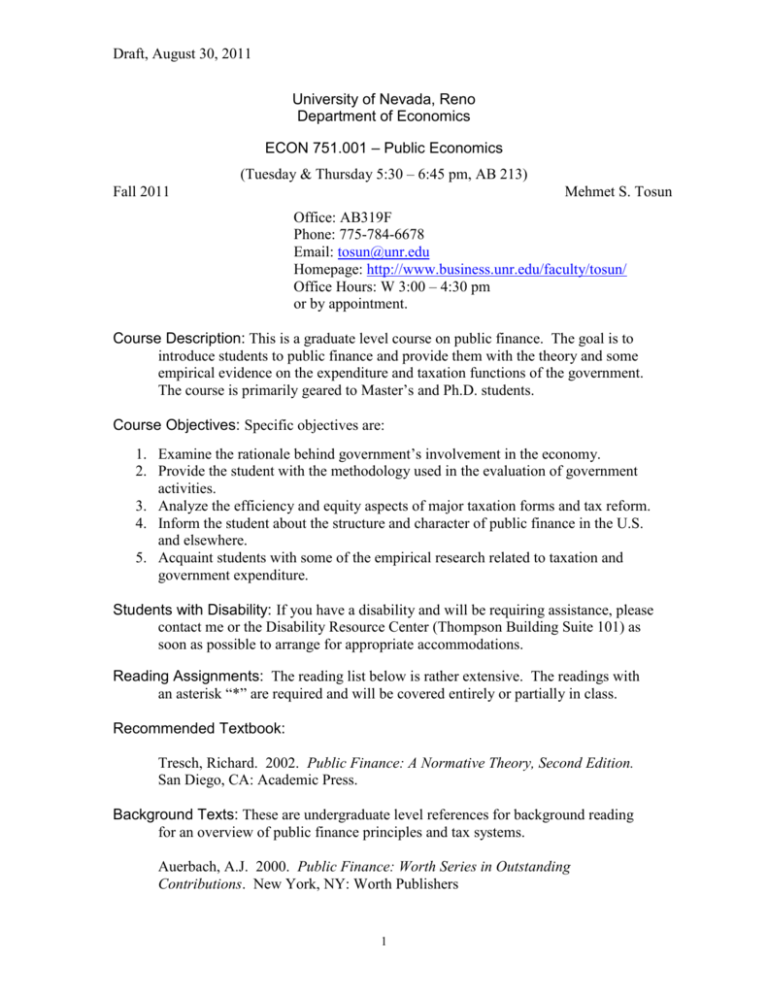
Draft, August 30, 2011 University of Nevada, Reno Department of Economics ECON 751.001 – Public Economics (Tuesday & Thursday 5:30 – 6:45 pm, AB 213) Fall 2011 Mehmet S. Tosun Office: AB319F Phone: 775-784-6678 Email: tosun@unr.edu Homepage: http://www.business.unr.edu/faculty/tosun/ Office Hours: W 3:00 – 4:30 pm or by appointment. Course Description: This is a graduate level course on public finance. The goal is to introduce students to public finance and provide them with the theory and some empirical evidence on the expenditure and taxation functions of the government. The course is primarily geared to Master’s and Ph.D. students. Course Objectives: Specific objectives are: 1. Examine the rationale behind government’s involvement in the economy. 2. Provide the student with the methodology used in the evaluation of government activities. 3. Analyze the efficiency and equity aspects of major taxation forms and tax reform. 4. Inform the student about the structure and character of public finance in the U.S. and elsewhere. 5. Acquaint students with some of the empirical research related to taxation and government expenditure. Students with Disability: If you have a disability and will be requiring assistance, please contact me or the Disability Resource Center (Thompson Building Suite 101) as soon as possible to arrange for appropriate accommodations. Reading Assignments: The reading list below is rather extensive. The readings with an asterisk “*” are required and will be covered entirely or partially in class. Recommended Textbook: Tresch, Richard. 2002. Public Finance: A Normative Theory, Second Edition. San Diego, CA: Academic Press. Background Texts: These are undergraduate level references for background reading for an overview of public finance principles and tax systems. Auerbach, A.J. 2000. Public Finance: Worth Series in Outstanding Contributions. New York, NY: Worth Publishers 1 Draft, August 30, 2011 Browning, E.K. and J.M Browning. 1994. Public Finance and the Price System, Fourth Edition, Upper Saddle River, New Jersey: Prentice Hall. Bruce, N. 2001. Public Finance and the American Economy, Second Edition. New York, NY: Addison, Wesley. Cordes, J.J., R.D. Ebel and J.G. Gravelle. 2005. The Encyclopedia of Taxation and Tax Policy, Second Edition. Washington, D.C.: The Urban Institute Press. Graetz, M. J. 1999. The U.S. Income Tax, New York: Norton. Gruber, Jonathan. 2010. Public Finance and Public Policy, Third Edition. New York, NY: Worth Publishers. (“Gruber”). Hyman, D. N. 2008. Public Finance: A Contemporary Application of Theory to Policy (9th Edition). Mason, OH: Thomson South-Western. Musgrave, Richard A. 1959. The Theory of Public Finance: A Study in Public Economy, New York: McGraw-Hill. Quigley, J.M. and E. Smolensky. 1994. Modern Public Finance, Cambridge: Harvard University Press. Rosen, H. S. and Ted Gayer. 2010. Public Finance (9th Edition). Boston: Irwin McGraw-Hill. Slemrod, J., and J. Bakija. 2008. Taxing Ourselves: A Citizen’s Guide to the Debate Over Taxes, Fourth Edition, Cambridge: MIT Press. Stiglitz, J.E. 2000. Economics of the Public Sector, Third Edition, New York, NY: W.W. Norton & Company. Steuerle, Eugene. 2004. Contemporary U.S. Tax Policy, Washington, D.C.: The Urban Institute Press. Tanzi, Vito and Howell Zee. 2001. Tax Policy for Developing Countries, Washington, D.C.: International Monetary Fund. Tresch, Richard. 2008. Public Sector Economics. New York, NY: Palgrave MacMillan. Student companion web site can be accessed at http://www.palgrave.com/economics/tresch/students/index.html Reference Texts: These are graduate textbooks on public economics. Atkinson, A.B. and J.E. Stiglitz. 1980. Lectures on Public Economics, New York: McGraw-Hill. 2 Draft, August 30, 2011 Auerbach, Alan J. and Martin S. Feldstein. 2002. Handbook of Public Economics, Volume 3 and 4, Amsterdam: North Holland. Auerbach, Alan J. and Martin S. Feldstein. 1985. Handbook of Public Economics, Volume 1 and 2, Amsterdam: North Holland. Cornes, Richard and Todd Sandler. 1996. The Theory of Externalities, Public Goods and Club Goods. Second Edition. New York: Cambridge University Press. Cullis, J. and P. Jones. 1998. Public Finance and Public Choice. Second Edition. New York: Oxford University Press. Groves, Harold M. 1974. Tax Philosophers: Two Hundred Years of Thought in Great Britain and the United States. Madison WI: The University of Wisconsin Press. Jha, Raghbendra. 1998. Modern Public Economics, New York: Routledge. Musgrave, Richard A. and Alan T. Peacock. 1967. Classics in the Theory of Public Finance. New York, NY: St Martin’s Press. Myles, Gareth D. 1995. Public Economics, Cambridge, MA: Cambridge University Press. Salanie, Bernard. 2003. The Economics of Taxation. Cambridge, MA: Cambridge University Press. Grading: The course grade is based on two problem sets (5% each), policy exercise (10%), a midterm exam (25%), a comprehensive final exam (30%), and a research paper (25%). Final exam is currently scheduled on Monday, December 19, 2011, 5:00 – 7:00 pm. Attendance to all class sessions is mandatory. This course uses a +/- scale for grading. Late Assignments: Students are expected to complete the problem sets, policy exercise and the research paper by the due dates indicated below. Failure to do so will result in zero credit for that assignment. Instructor should be notified of any problems regarding the completion of the assignments prior to the deadlines. Research Paper: The objective here is to provide students with a compact research experience. Students are expected to turn this into a publishable paper. The writing of the paper will include the following four steps: Brainstorming: Come up with three research ideas that interest you the most. You can discuss these with me during my office hours. You will then choose one of these ideas as a research project for this semester. Referee Report: Find a working paper (not a paper published in a journal) that is closely related to your research idea and write a referee report on it (see below for more information on the referee report). There should be a 3 Draft, August 30, 2011 section where you discuss what you would have done differently if you had written that paper. Proposal and Outline: Use the working paper from the previous step and your referee report as the starting point and write a one-page research proposal together with a detailed research outline that includes a preliminary list of references. Presentation: Present a draft of the paper to the class for comments. The draft should be distributed in class one week before the presentation. Referee Report: One interesting aspect of academic life is reading as well as writing referee reports for articles submitted to journals. Graduate students can greatly benefit from this exercise. Instructional material on how to write a referee report will be provided. Policy Exercise: In this assignment you will analyze a fictitious policy case using the theories you have learned in this class. This exercise will be assigned towards the end of the term. Special Class Sessions: Time permitting, I plan to arrange special session(s) on topics that will be determined later. Guest speakers and special class sessions will be announced later in class. Internet Information: Some of the papers in the reading list have hyperlinks to electronic copies through JSTOR, NBER and IZA databases and other publicly available journals such as National Tax Journal. On your electronic copy of the syllabus, you can click on links to have access to these papers in pdf. Academic Integrity: Honesty and personal integrity are key facets of the University of Nevada community. The issue of academic integrity is taken very seriously at the University and College of Business Administration. Since the majority of students take pride in total academic integrity, it is hoped that you, as a student, will take action to influence the practice of integrity in academic community. I understand that students feel pressure to perform well in their classes, and I will do everything that I can to ensure that you have the resources necessary to succeed. However, cheating on exams and course assignments will not be tolerated, and students who fail to comply with the University’s honor code (www.unr.edu/stsv/acdispol.html, www.unr.edu/stsv/nsop/dishones.htm) will be subject to the maximum university penalties. Please visit the university website if you are unfamiliar with the actions which constitute academic dishonesty. 4 Draft, August 30, 2011 Outline of Topics and Readings: 1. Introduction and Review of Welfare Economics Background: Tresch (2008), Chapters 1-3; Tresch (2002), Chapter 1, or from your favorite micro textbook. Also check the web site http://www.thenewpublicfinance.org/ for supporting materials on the New Public Finance. *Buchanan, James M. and Richard A. Musgrave. 1999. Public Finance and Public Choice: Two Contrasting Visions of the State, Cambridge, MA: MIT Press. Chapter 12.1. Buchanan, James M. 1987. “The Constitution of Economic Policy,” American Economic Review, 77 (3): 243-250. http://www.jstor.org *Kaul, Inge and Pedro Conceicao. 2006. “Overview: Why Revisit Public Finance Today?” in The New Public Finance, Responding to Global Challenges. New York, NY: Oxford University Press: 1-27. Musgrave, Richard A. and Peggy B. Musgrave. 1980. Public Finance in Theory and Practice, New York: McGraw-Hill. Chapter 1. *Poterba, James M. 1998. “Public Finance and Public Choice,” National Tax Journal, 51 (2): 391-396. http://ntj.tax.org 2. Public Goods Background: Tresch (2008) Chapters 4,5 and 8 Also check the web site http://www.globalpublicgoods.org/ for background papers and supporting materials on global public goods. Lindahl, E. 1958. “Just Taxation – A Positive Solution,” in Musgrave and Peacock, eds., Classics in the Theory of Public Finance, Macmillan, pp. 168-176. Musgrave, Richard A. 1939. “The Voluntary Exchange Theory of Public Economy,” Quarterly Journal of Economics, 53 (2): 213-237. http://www.jstor.org *Oakland, W. 1987. “Theory of Public Goods.” Chapter 9, Handbook of Public Economics, Vol. 2, pp. 485-535. *Samuelson, P.A. 1954. “The Pure Theory of Public Expenditure,” Review of Economics and Statistics, 36 (4): 387-389. http://www.jstor.org *Samuelson, P.A. 1955. “Diagrammatic Exposition of a Theory of Public Expenditure,” Review of Economics and Statistics, 37 (4): 350-356. http://www.jstor.org 5 Draft, August 30, 2011 Sandmo, Agnar. 2003. “International Aspects of Public Goods Provision,” in Providing Global Public Goods, I.Kaul, P. Conceicao, K.Le Goulven and R.U.Mendoza eds. New York, NY: Oxford University Press: 112-130. 3. Externalities Background: Tresch (2008), Chapters 6 and 7; Tresch (2002), Chapter 5 Bovenberg, A. Lans and Lawrence H. Goulder. 2001. “Environmental Taxation and Regulation,” NBER Working Paper No. 8458. http://papers.nber.org/papers/W8458 Also in Handbook of Public Economics, Volume 3, Amsterdam: North Holland. *Coase, R. 1960. “The Problem of Social Cost,” Journal of Law and Economics, pp.144. Ebrill, L. and S. Slutsky. 1982. “Time, Congestion, and Public Goods,” Journal of Public Economics, 17 (3): 307-334. *Farrell, Joseph. 1987. “Information and the Coase Theorem,” Journal of Economic Perspectives, 1 (2): 113-129. http://www.jstor.org Fullerton, D. and A. Wolverton. 2005. “The Two-Part Instrument in a Second-Best World” Journal of Public Economics 89: 1961-1975. *Fullerton, D. and A. Wolverton. 1999. “The Case for a Two-part Instrument: Presumptive Tax and Performance Subsidy” in Environmental and Public Economics: Essays in Honor of Wallace E. Oates, A. Panagaria, P. Portney and R. Schwab, eds., Cheltenham, UK: Edward Elgar: 32-57. Available as NBER paper 5993. Fullerton, D. and S. West. 2000. “Tax and Subsidy Combinations for the Control of Car Pollution,” NBER Working Paper W7774. http://papers.nber.org/papers/W7774. *Hardin, Garren. 1968. “The Tragedy of the Commons,” Science, December. Maskin, Eric S. 1994. “The Invisible Hand and Externalities,” American Economic Review, 84 (2): 333-337. Rosenkranz, S. and P. Schmitz. 2004. “Can Coasian Bargaining Justify Pigouvian Taxation?” CEPR Working Paper 4263. *Wiggins, S. and G. Libecap. 1985. “Oil Field Unitization: Contractual Failure in the Presence of Imperfect Information,” American Economic Review, 75 (3): 368-385. http://www.jstor.org 6 Draft, August 30, 2011 4. An Introduction to Taxation Check the Tax Analysts’ web site: http://www.taxanalysts.com/www/freefiles.nsf/Files/Yablon.pdf/$file/Yablon.pdf for a recent collection of tax quotes. 4.1. Excess Burden Background: Tresch (2008), Chapter 15 Auerbach, Alan J. and James R. Hines. 2001. “Taxation and Economic Efficiency,” NBER Working Paper No. 8181. http://papers.nber.org/papers/w8181.pdf Also in Handbook of Public Economics, Volume 3, Amsterdam: North Holland. Goulder, Lawrence H. and Roberton C. Williams III. 1999. “The Usual Excess Burden Approximation Usually Doesn’t Come Close,” NBER Working Paper No. 7034. http://papers.nber.org/papers/w7034.pdf Harberger, Arnold C. “Three Basic Postulates for Applied Welfare Economics: An Interpretive Essay,” Journal of Economic Literature 9:3 (1971), 785-797. http://jstor.org *Hausman, J.A. 1981. “Exact Consumer’s Surplus and Deadweight Loss,” American Economic Review, 71 (4): 662-676. http://www.jstor.org Hines, Jr., J.R. 1999. “Three Sides of Harberger Triangles,” Journal of Economic Perspectives, 13 (2): 167-188. Tresch (2002), Chapter 13, 401-429. Rosen, Harvey S., “The Measurement of Excess Burden with Explicit Utility Functions,” Journal of Political Economy 86:2 (1978), S121-S135. http://jstor.org Goulder, L.H. and R.C. Williams. 2003. “The Substantial Bias From Ignoring General Equilibrium Effects in Estimating Excess Burden, and a Practical Solution,” Journal of Political Economy, 111 (4): 898-927. *Willig, Robert, “Consumer’s Surplus Without Apology,” American Economic Review 66:4 (1976): 589-597. http://jstor.org *Browning, E.K. 1987. “On the Marginal Welfare Cost of Taxation,” American Economic Review, 77 (1): 11-23. http://www.jstor.org *Browning, E.K. 1976. “The Marginal Cost of Public Funds,” Journal of Political Economy, 84 (2): 283-298. http://www.jstor.org 7 Draft, August 30, 2011 Fullerton, D. 1991. “Reconciling Recent Estimates of the Marginal Welfare Cost of Taxation,” American Economic Review, 81 (1): 302-307. Kleven, H.J. and C.T. Kreiner. 2003. “The Marginal Cost of Public Funds in OECD Countries: Hours of Work vs. Labor Force Participation,” CESifo Working Paper No. 935. Stuart, C. 1984. “Welfare Costs per Dollar of Additional Tax Revenue in the United States,” American Economic Review 74 (3): 352-362. http://jstor.org 5. Optimal Taxation Background: Tresch (2008), Chapter 16 Atkinson, A. and N. Stern. “Pigou, Taxation, and Public Goods,” Review of Economic Studies, 41 (1): 119-128. http://www.jstor.org Diamond, P. and J. Mirrlees. 1971. “Optimal Taxation and Public Production I: Production Efficiency,” American Economic Review, 61 (1): 8-27. http://www.jstor.org Diamond, P. and J. Mirrlees. 1971. “Optimal Taxation and Public Production II: Tax Rules,” American Economic Review, 61 (3): 261-278. http://www.jstor.org *Diamond, P. 1975. “A Many-Person Ramsey Tax Rule,” Journal of Public Economics, 4: 335-342. Giertz, Seth. 2004. “Recent Literature on Taxable Income Elasticities,” CBO Technical Paper 16 (December). Washington D.C.: Congressional Budget Office. *Mankiw, Gregory, M. Weinzierl and D. Yagan. 2009. “Optimal Taxation in Theory and Practice,” NBER Working Paper No. 15071. http://www.nber.org/papers/w15071. Ramsey, Frank P. 1927. “A Contribution to the Theory of Taxation,” Economic Journal, March. http://www.jstor.org Sandmo, A. 1975. “Optimal Taxation in the Presence of Externalities,” Swedish Journal of Economics, pp.86-98. *Slemrod, J. 1990. “Optimal Taxation and Optimal Tax Systems,” Journal of Economic Perspectives, 4 (1): 157-178. http://www.jstor.org *Smith, P. 1991. “Lessons from the British Poll Tax Disaster,” National Tax Journal, 44 (4): 421-436. Stern, Nicholas H. 1976. “On the Specification of Models of Optimum Income Taxation,” Journal of Public Economics 6 (1): 123-162. 8 Draft, August 30, 2011 Stern, Nicholas. 1987. “The Theory of Optimal Commodity and Income Taxation: An Introduction,” in D. Newbery and N. Stern, eds., The Theory of Taxation in Developing Countries, Oxford: Oxford University Press: pp.22-59. Tresch (2002), Chapter 13, 429-444; Chapter 14, 461-482. 6. Tax Incidence Background: Tresch (2008), Chapters 18 and 19 Atkinson, A.B. 1994. “The Distribution of the Tax Burden,” in J.M. Quigley and E. Smolensky, eds., Modern Public Finance, Cambridge: Harvard University Press: pp. 1349. Congressional Budget Office. 1996. The Incidence of the Corporate Income Tax, Washington, D.C. Slemrod, J. and J. Bakija. 2008. Taxing Ourselves: A Citizen’s Guide to the Great Debate Over Taxes, Fourth Edition, Cambridge: MIT Press, Chapter 3. 6.1. Partial Equilibrium Fullerton, D. and G.E. Metcalf. 2002. “Tax Incidence,” NBER working paper 8829. Goolsbee, A. 2000. “In a World Without Borders: The Impact of Taxes on Internet Commerce,” Quarterly Journal of Economics, 115 (2): 561-576. Kotlikoff, L. and L.H. Summers. 1987. “Tax Incidence,” in A. Auerbach and M. Feldstein, eds., Handbook of Public Economics, Volume 2, Amsterdam: North Holland: pp.1043-1092. 6.2. General Equilibrium Diamond, P. 1978. “Tax Incidence in a Two-Good Model,” Journal of Public Economics, 9: 283-299. Fullerton, D. and G.E. Metcalf. 2002. “Tax Incidence,” NBER working paper 8829. *Harberger, A.C. 1962. “The Incidence of the Corporation Income Tax,” Journal of Political Economy, 70 (3): 215-240. http://www.jstor.org Mclure, C. 1975. “General Equilibrium Incidence Analysis,” Journal of Public Economics, February. Tresch (2002), Chapter 16, 549-571. 9 Draft, August 30, 2011 6.3. Lifecycle and Intergenerational Tax Incidence Auerbach, A.J., J. Gokhale, and L.J. Kotlikoff. 1994. “Generational Accounting: A Meaningful Way to Evaluate Fiscal Policy,” Journal of Economic Perspectives, 8 (1): 73-94. Barthold, Thomas A. 1993. “How Should We Measure Distribution,” National Tax Journal 46 (3): 291-299. Fullerton, D. and D.L. Rogers. 1993. Who Bears the Lifetime Tax Burden?, Washington: Brookings Institution. Chapter 1. *Fullerton, D. and D.L. Rogers. 1991. “Lifetime Versus Annual Perspective on Tax Incidence,” National Tax Journal, 44(3): 277-287. Metcalf, Gilbert E. 1993. “The Lifetime Incidence of State and Local Taxes: Measuring Changes During the 1980s,” NBER Working Paper No. 4252. http://papers.nber.org/papers/w4252.pdf *Pechman, J.A. 1986. Who Paid the Taxes, 1966-1985, Washington: Brookings Institution. Chapter 3 and 4. *Poterba, James M. 1989. “Reexaminations of Tax Incidence,” American Economic Review, 79 (2): 325-330. http://www.jstor.org Tresch (2002), Chapter 17, 606-621. 6.4. Applied Incidence Studies Ebel, Robert D. 1990. A Fiscal Agenda for Nevada. Reno, NV: University of Nevada Press. Feldstein, M. 1988. “Imputing Corporate Tax Liabilities to Individual Taxpayers,” National Tax Journal, 41 (1): 37-59. Gade, M., and L. Adkins, 1990. “Tax Exporting and State Revenue Tax Structures”, National Tax Journal 43: 39-42. Joint Committee on Taxation. 1993. Methodology and Issues in Measuring Changes in the Distribution of Tax Burdens, June 14, Washington: U.S. Government Printing Office. McLure, C.E., 1967. “The Interstate Exporting of State and Local Taxes: Estimates for 1962”, National Tax Journal, 20 (1): 49-77. Musgrave, R.A. and D. Daicoff. 1958. “Who Pays the Michigan Taxes?” Michigan 10 Draft, August 30, 2011 Tax Study Staff Papers, Lansing: Secretary of Finance, 131-183. Musgrave, R.A., J.J. Carroll, L.D. Cook and L.Frane. 1951. “Distribution of Payments by Income Groups: A Case Study for 1948,” National Tax Journal, 4 (1): 1-53. Pechman, J.A. and B.A. Okner. 1971. Who Bears the Tax Burden?, Washington: Brookings Institution. Pechman, J.A. 1986. Who Paid the Taxes, 1966-1985, Washington: Brookings Institution. Phares, D., 1980. Who Pays State and Local Taxes?, Cambridge, Massachusetts: Oelgeschlager, Gunn and Hain, Publishers, Inc. Chapter 4. Pollock, S.H., 1991. “Mechanisms for Exporting the State Sales Tax Burden in the Absence of Federal Deductibility” National Tax Journal 44: 297-310. Tresch (2002), Chapter 17. Yakovlev, Pavel, Mehmet S. Tosun and Arzu Sen. 2007. “The Economic Incidence of West Virginia Taxes.” WV Public Finance Program Special Report. 6.5. Open Economy Tax Incidence Eijfinger, Sylvester C.W. and Wolf Wagner. 2001. “Taxation if Capital is not Perfectly Mobile: Tax Competition Versus Tax Exportation,” Center for Economic Policy Research Discussion Paper No. 3084. www.cepr.org Gravelle, Jane G. and Smetters, Kent A. (2006) "Does the Open Economy Assumption Really Mean That Labor Bears the Burden of a Capital Income Tax?," Advances in Economic Analysis & Policy: Vol. 6 : Iss. 1, Article 3. Available at: http://www.bepress.com/bejeap/advances/vol6/iss1/art3 Razin, A. and E. Sadka. 2004. “Capital Income Taxation in the Globalized World,” NBER Working Paper 10630. 7. Taxation and Labor Supply Background: Gruber, Chapter 21 Duncan, Denvil and Klara Sabirianova Peter. 2009. “Does Labor Supply Respond to a Flat Tax? Evidence from the Russian Tax Reform,” IZA Disucssion Paper No. 4257. 11 Draft, August 30, 2011 *Eissa, Nada. 1995. “Taxation and Labor Supply of Married Women: The Tax Reform Act of 1986 as a Natural Experiment,” NBER Working Paper No. 5023. http://papers.nber.org/papers/W5023 *Eissa, Nada. 1996. “Labor Supply and the Economic Recovery Tax Act of 1981,” in Empirical Foundations of Household Taxation, M. Feldstein and J. Poterba eds., Chicago: University of Chicago Press: 5-38. Feldstein, M. 1995. “The Effect of Marginal Tax Rates on Taxable Income: A Panel Study of the 1986 Tax Reform Act,” Journal of Political Economy, 103 (3): 551-572. *Hausman, Jerry A. 1985. “Taxes and Labor Supply,” in Handbook of Public Economics, Volume 1, Alan Auerbach and Martin Feldstein, eds., Amsterdam: North Holland: 213-265. Hausman, Jerry A. 1985. “The Econometrics of Non-Linear Budget Sets,” Econometrica, 53 (6): 1255-1282. http://www.jstor.org *Heckman, J.J. 1982. “Comment”, in Behavioral Simulations in Tax Policy Analysis, Martin Feldstein ed., Chicago: University of Chicago Press: Chicago: 70-82. Moffitt, R. 1990. “The Econometrics of Kinked Budget Constraints,” Journal of Economic Perspectives, 4 (2): 119-139. http://www.jstor.org Saez, Emmanuel, Joel Slemrod and Seth Giertz. 2009. “The Elasticity of Taxable Income with Respect to Marginal Tax Rates: A Critical Review,” NBER Working Paper No. 15012. http://www.nber.org/papers/w15012 8. Taxation and Saving Background: Gruber, Chapter 22 *Shapiro, Matthew D. and Joel Slemrod. 2009. “Did the 2008 Tax Rebates Stimulate Spending?,” NBER Working Paper No. 14753. http://www.nber.org/papers/w14753 8.1. Household Saving Auerbach, A.J. and J. Slemrod. 1997. “The Economic Effects of the Tax Reform Act of 1986,” Journal of Economic Literature, 35 (June): 589-632. Boskin, M. J. 1978. “Taxation, Saving and the Rate of Interest,” Journal of Political Economy, 86 (2) part 2: S3-S27. Bernheim, B.D. 2000. “Taxation and Saving,” NBER Working Paper No. 7061, and forthcoming in Handbook of Public Economics, Volume 3, A.J. Auerbach and M. Feldstein, eds., Amsterdam: Elsevier Science Publishers B.V. 12 Draft, August 30, 2011 http://www.papers.nber.org/papers/W7061 *Feldstein, M. 1978. “The Welfare Cost of Capital Income Taxation,” Journal of Political Economy 86 (April): S29-52. *Summers, L.H. 1981. “Capital Taxation and Accumulation in a Life Cycle Model,” American Economic Review, 71 (September): 533-544. http://www.jstor.org 8.2. Portfolio Composition Feldstein, M. 1976. “Personal Taxation and Portfolio Composition: An Econometric Analysis,” Econometrica, 44 (4): 631-650. http://www.jstor.org *Poterba, J.M. 2001. “Taxation, Risk-Taking, and Household Portfolio Behavior,” NBER Working Paper No. 8340. http://papers.nber.org/papers/W8340 Also in Handbook of Public Economics, Volume 3, Amsterdam: North Holland. *Poterba, J.M. and A. Samwick. 2002. “Taxation and Household Portfolio Composition: U.S. Evidence from the 1980s and 1990s,” Journal of Public Economics, 87: 5-32. Also published as “Taxation and Household Portfolio Composition: U.S. Evidence from the 1980s and 1990s,” 1999, NBER Working Paper No. 7392. http://papers.nber.org/papers/W7392 8.3. Capital Gains *Auten, G. and J. Cordes. 1991. “Cutting Capital Gains Taxes,” Journal of Economic Perspectives, Winter, pp.181-192. http://www.jstor.org *Burman, L.E. The Labyrinth of Capital Gains Tax Policy, Washington, D.C.: Brookings. (read chapter 4) http://brookings.nap.edu/books/0815712707/html/index.html Burman, L.E. and William C. Randolph. 1994. “Measuring Permanent Responses to Capital-Gains Tax Changes in Panel Data,” American Economic Review, 84 (4): 794809. 8.4 Social Security Background: Tresch (2008), Chapter 12 Barro, R. 1974. “Are Government Bonds Net Wealth?,” Journal Political Economy, 82 (6): 1095-1117. http://www.jstor.org *Feldstein, M. 1974. “Social Security, Induced Retirement and Aggregate Capital Accumulation,” Journal of Political Economy, 82 (5): 905-926. http://www.jstor.org 13 Draft, August 30, 2011 *Feldstein, M. 1982. “Social Security and Private Saving: Reply,” Journal of Political Economy, 90 (3): 630-642. http://www.jstor.org *Feldstein, M. 1996. “Social Security and Saving: New Time Series Evidence,” National Tax Journal, 49 (2): 151-164. International Monetary Fund. 2004. World Economic Outlook, September. The analytic chapter on global aging (Chapter 3) can be downloaded from the IMF web site www.imf.org. Leimer, D.R. and S.D. Lesnoy. 1982. “Social Security and Private Saving: New Time-Series Evidence,” Journal of Political Economy, 90 (3): 606-629. Tosun, Mehmet S. 2009. “Global Aging and Fiscal Policy with International Labor Mobility: A Political Economy Perspective,” IZA Discussion Paper No. 4166. Tosun, Mehmet S. 2008. “Endogenous Fiscal Policy and Capital Market Transmissions in the Presence of Demographic Shocks,” Journal of Economic Dynamics and Control, 32: 2031-2060. 9. Taxation and Firm Behavior (will be covered if time permits) Background: Gruber, Chapter 24 9.1. Taxation and Firm Investment Auerbach, A. 1983. “Taxation, Corporate Financial Policy, and the Cost of Capital,” Journal of Economic Literature, 21: 905-940. http://www.jstor.org Cummins, J., K. Hassett and R.G. Hubbard. 1994. “A Reconsideration of Investment Behavior Using Tax Reforms as Natural Experiments,” Brookings Papers on Economic Activity, 2: 1-59. *Hall, R.E. and D. Jorgenson. 1967. “Tax Policy and Investment Behavior,” American Economic Review, 57 (3): 391-414. http://www.jstor.org *Hassett, Kevin A. and R. Glenn Hubbard. 1998. “Tax Policy and Investment,” NBER Working Paper No. 5683. http://papers.nber.org/papers/W5683 Also in Handbook of Public Economics, Volume 3, Amsterdam: North Holland. Hayashi, F. 1982. “Tobin’s Marginal q and Average q: A Neoclassical Interpretation,” Econometrica, 50 (1): 213-224. http://www.jstor.org *Summers, L.H. 1981. “Taxation and Corporate Investment: A q Theory Approach,” Brookings Papers on Economic Activity, 1: 67-127. 14 Draft, August 30, 2011 9.2. Taxation and Firm Financial Policy *Auerbach, Alan J. 2001. “Taxation and Corporate Financial Policy,” NBER Working Paper No. 8203. http://papers.nber.org/papers/W8203 Also in Handbook of Public Economics, Volume 3, Amsterdam: North Holland. *Gordon, R.H. and Y. Lee. 1999. “Do Taxes Affect Corporate Debt Policy? Evidence from U.S. Corporate Tax Return Data,” NBER Working Paper No. 7433, December. http://papers.nber.org/papers/W7433 Mackie-Mason, J. 1990. “Do Taxes Affect Corporate Financing Decisions,” Journal of Finance, 45: 1471-1494. http://www.jstor.org Miller, M. 1977. “Debt and Taxes,” Journal of Finance, 32: 261-275. http://www.jstor.org *Poterba, J.M. and L.H. Summers. 1985. “The Economic Effects of Dividend Taxation,” in E. Altman and M. Subrahmanyam, eds., Recent Advances in Corporation Finance, Homewood, IL: Dow Jones-Irwin: pp.227-284. 10. Fiscal Federalism (will be covered if time permits) Background: Tresch (2008), pp. 423-455. Akai, Nobuo and M. Sakata. 2002. “Fiscal Decentralization Contributed to Economic Growth: Evidence from State-Level Cross-Section Data for the United States,” Journal of Urban Economics, 52: 93-108. Arzhagi, Mohammad and J. Vernon Henderson. 2005. “Why Countries are Fiscally Decentralizing,” Journal of Public Economics 89: 1157-1189. *Hammond, George and Mehmet S. Tosun. 2011. “The Impact of Local Decentralization on Economic Growth: Evidence from U.S. Counties,” Journal of Regional Science 51 (1): 47-64. *Martinez-Vaquez, Jorge and R.M. McNab. 2003. “Fiscal Decentralization and Economic Growth,” World Development, 31 (9): 1597-1616. McLure, Charles E. 2001. “The Tax Assignment Problem: Ruminations on How Theory and Practice Depend on History,” National Tax Journal 54 (2): 339-364. Oates, Wallace E. 1993. “Fiscal Decentralization and Economic Development,” National Tax Journal, 46 (2): 237-243. Oates, Wallace E. 1972. Fiscal Federalism. New York, NY: Harcourt Brace Jovanovich, Academic Press. 15 Draft, August 30, 2011 Panizza, Ugo. 1999. ”On the Determinants of Fiscal Centralization: Theory and Evidence,” Journal of Public Economics 74: 97-139. Stansel, Dean. 2005. “Local decentralization and Local Economic Growth: A CrossSectional Examination of US Metropolitan Areas,” Journal of Urban Economics, 57: 5572. Tosun, Mehmet S. and Serdar Yilmaz. 2010. “Centralization, Decentralization and Conflict in the Middle East and North Africa,” Middle East Development Journal 2 (1): 1-14. (earlier version published as World Bank MENA Working Paper Series No.51 and World Bank Policy Research Working Paper 4774. http://econ.worldbank.org/external/default/main?pagePK=64165259&theSitePK=469372 &piPK=64165421&menuPK=64166093&entityID=000158349_20081110112652 *Tresch, Richard. 2002. Public Finance. Chapters 29 and 30, pp. 831-891. 16
